Guillaume Coustou the Elder
Guillaume Coustou the Elder (November 29, 1677, Lyon - February 22, 1746, Paris) was a French sculptor of the Baroque and Style Louis XIV. He was a royal sculptor for Louis XIV and Louis XV and became Director of the Royal Academy of Painting and Sculpture in 1735. He is best known for his monumental statues of horses made for the Chateau of Marly, whose replicas now stand in the Place de la Concorde in Paris.[1]
Guillaume Coustou the Elder | |
|---|---|
 'Guillaume Coustou the Elder by Jacques-François Delyen, in the Palace of Versailles, Salle Louis XIV | |
| Born | 29 November 1677 |
| Died | 22 February 1746 |
| Nationality | French |
| Known for | Sculpture |
| Movement | Baroque and Style Louis XIV |
- See also: Guillaume Coustou the Younger, son of Guillaume the Elder
Life
Coustou was a member of a family of famous sculptors; his uncle, Antoine Coysevox, was a royal sculptor; his elder brother, Nicolas Coustou was a sculptor, and his son Guillaume Coustou the Younger also become a noted royal sculptor. Like his older brother, he won the (Prix de Rome) of the Royal Academy which entitled him to study for four years at the French Academy in Rome. However, he refused to accept the discipline of the Academy, gave up his studies, set out to make his own career as an artist. He worked for a time in the atelier of the painter Pierre Legros, and eventually returned to Paris.[2]
Upon his return to Paris, he assisted his uncle Coysevox in making two monumental equestrian sculptures, Fame and Mercury, for the Château de Marly, the new residence of Louis XIV near the Palace of Versailles, where he went to escape the crowds and ceremony of the Palace. In 1740-45, He later (1740–45, made his own horses, The Horses of Marly, his most famous works, to replace them. The horses reinvent the theme of the colossal Roman marbles of the Horse Tamers in the Piazza Quirinale, Rome. They were commissioned by Louis XV in 1739 and installed in 1745 at the Abreuvoir ("Horse Trough") at Marly. The horses were considered masterpieces of the grace and expressiveness of the French Late Baroque or Rococo style.[3] After the Revolution they were moved from Marly to the beginning of the Champs Elysees on the Place de la Concorde. The originals were brought indoors for protection at the Louvre Museum in 1984.
In 1704 Coustou was received into the Académie royale de peinture et de sculpture. The work he made to mark his entrance was Hercules on the Pyre, now in the Louvre. It displays the special hallmark of the Baroque, a twisting and rising transverse pose, as well as highly skillful carving. He rose to become Director of the Academy in 1733.
Another of his major works from his later career, the statue of Maria Leszczynska, (1731)is on display at the Louvre.[4]
Coustou also created two colossal monuments, The Ocean and the Mediterranean among other sculptures for the park at Marly; the bronze Rhone, which formed part of the statue of Louis XIV at Lyons, and the sculptures at the entrance of the Hôtel des Invalides. Of these latter, the bas-relief representing Louis XIV mounted and accompanied by Justice and Prudence was destroyed during the Revolution, but was restored in 1815 by Pierre Cartellier from Coustou's model; the bronze figures of Mars and Minerva (1733–34), on either side of the doorway, were not interfered with.[5]
In 1714 for Marly he collaborated in two marble sculptures representing Apollo Chasing Daphne (both at the Louvre), in which Nicolas Coustou sculpted the Apollo and Guillaume the Daphne. About the same time he was commissioned to produce another running figure in marble, a Hippomenes designed to complement an Atalanta copied from the Antique by Pierre Lepautre: each was placed at the center of one of the carp pools at Marly.[6]
In 1725 the duc d'Antin, general director of the Bâtiments du Roi commissioned a pair of life-size marbles of Louis XV as Jupiter and Marie Leszczynska as Juno for the park of his château de Petit-Bourg, which adjoined the park of Versailles, to which it was added after the duke's death.[7]
A number of his sculptures were for the Tuileries Gardens, most notably a bronze Diane à la biche ("Diana and a Deer"), and Hippoméne (1714), which was originally in the goldfish pond at Marly, then moved to the Tuileries until 1940, when it was brought into the Louvre.
Coustou's marble Bust of Samuel Bernard is at the Metropolitan Museum of Art, Guillaume often worked with his brother Nicolas Coustou, particularly in the decoration of royal domestic architecture at Versailles.
Sculpture
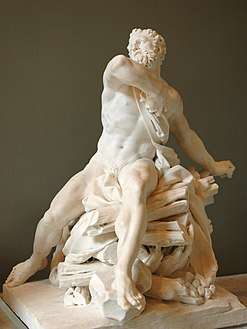 Hercules on the pyre, (1704), the Louvre
Hercules on the pyre, (1704), the Louvre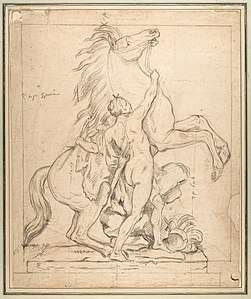 Study for one of the horses of Marly (Metropolitan Museum)
Study for one of the horses of Marly (Metropolitan Museum)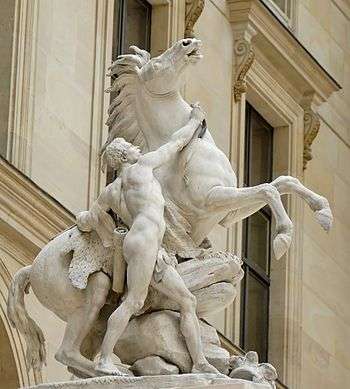 One of the Chevaux de Marly
One of the Chevaux de Marly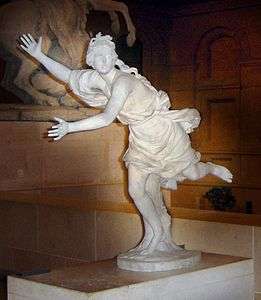 Daphne chased by Apollo, Louvre
Daphne chased by Apollo, Louvre- Allegory of the Rhone River, Lyon
 Marie Leszczynska, the Louvre
Marie Leszczynska, the Louvre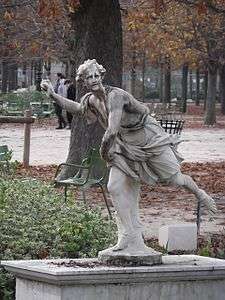 Hippomène, Tuileries Garden
Hippomène, Tuileries Garden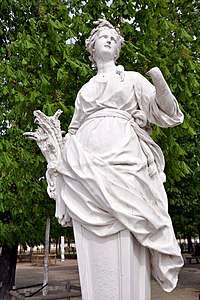 Summer from The Four Seasons, originally at Marly, now in Tuileries Gardens
Summer from The Four Seasons, originally at Marly, now in Tuileries Gardens_MET_DP239024.jpg) Bust of Samuel Bernard
Bust of Samuel Bernard
Notes and Citations
- Geese 2015, p. 310.
- Le Petit Robert des Noms Propres (2010)
- Le Petit Robert des Noms Propres (2010)
- Le Petit Robert des Noms Propres (2010)
- Encyclopedia Britannica (1911) article on Coustou
- Encyclopedia Britannica (1911) article on Coustou
- Encyclopedia Britannica (1911) article on Coustou
| Wikimedia Commons has media related to Guillaume Coustou the Elder. |
Bibliography
- Geese, Uwe, Section on Baroque sculpture in L'Art Baroque - Architecture - Sculpture - Peinture (French translation from German), H.F. Ulmann, Cologne, 2015. (ISBN 978-3-8480-0856-8)
- Le Petit Robert des Noms Propres, Paris (2010), (ISBN 978-2-84902-740-0)

- Louvre website: Guillaume I Coustou, Hippomène
External links
- Guillaume Coustou the Elder in American public collections, on the French Sculpture Census website
